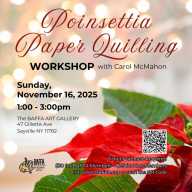The dreaded fall breeze traverses the South Shore Beaches, reminding us that summer has ended. We mourn the fun in the sun.
An estimated two million people visit Fire Island and the waters around it each summer. They crowd the train station platforms bound for Patchogue, Sayville Bay Shore, and Babylon.
But after Labor Day, the beaches that swell with youthful vitality are soon deserted as the rhythm of nature removes the extra feet of replenished sand.
While some surfers who cut the best wave breaks of the season hang up their boards, others plot their best days to come with the first cold snap, as snow, rain, or shine will not limit the determined.
One can enjoy the biggest waves and swells towards the end of hurricane season in late fall. For the most desired conditions, Montauk Ditch Plains is legendary for its great breaks and barrel waves during the winter months. Despite the ideal conditions, the average winter water temperatures range from 36 to 42 degrees.
Pioneering surfer Edward “Fast Eddie” McCabe recalled his first winter surf as almost unbearable”
“We did not have wet suits then; they became available in the late 60s. But one February day, the waves were too good to pass up in Long Beach. I put on a pair of long johns and paddled out. I lasted two waves until I ran back to my friend’s house for a hot shower. The only thing similar to a wet suit was a skin-diving suit, which gave you chafing. The Northeast gets big waves during the winter, and many of us crazy people found a way.”
Today, many alternatives exist to long johns and chafing skin-diving suits.
“A 5/4 mm hooded winter suit, with a 5mm three-finger glove, will work best for protection for up to below zero-degree temperatures,” surfing expert Charlie Bunger Jr. stated.
Overlooking the temperature challenges, George Daloia explains, “The only downside I can remember was one season walking from Field Two Robert Moses to Democratic Point in a steep snow drift. I found the wave breaks mostly the same in the off-season at Democratic Point, but it is just you and the ocean, not anyone else. It feels like your own private beach, peaceful and relaxing. My best memory of surfing was in February, sitting on my board with waves beneath me and watching it snow. It was a euphoric experience.”
Avid surfer Michael Vitti believes it all concerns your state of mind.

“Winter surfing gave me more time to perfect my maneuvers and improve my tube riding skills. Winter waves are more consistent with offshore winds that groom them with perfection. The cold is something to ignore; it became a mind game. I created a comfort calculation over the years to help me brave the cold. It goes like this: If you add the water temperature to the air temperature and it equals 80 degrees or more, I will be comfortable (for example, 40 degrees air temp and 40 degrees water temp). If it equals less than 80 degrees, I will be uncomfortable and would need really good waves to go out there.”
Michael went on to recall a date: February 28, 1993.
“Wet suit technology was not great. I had a leak in my suit, but the waves were epic from a classic nor’easter. The air temperature was 20 degrees, and the water temperature was 30 degrees, but the waves looked so good. I paddled out, but the first wave pounded me; it felt like I would drown due to cold water shock, so I headed back to the beach.
“Another surfer entering the water asked me to return and keep him company. So, I agreed, and we traded epic waves. After a while, I could not feel my arms or legs anymore. I had to get out or die from hypothermia.
The guy with me saw the wave of the day. The wave behind us was bigger, and about to annihilate me. I spun around. It was surf or die. I was lifted out of the water, directing my body on the wave. It was surreal. I stalled at the hook, got covered in a tube, and surfed it to the beach.”
Winter surfing is not for the inexperienced or faint of heart, but a hardcore few have ridden the waves of legacy that winter surfing on Long Island has to offer.





























